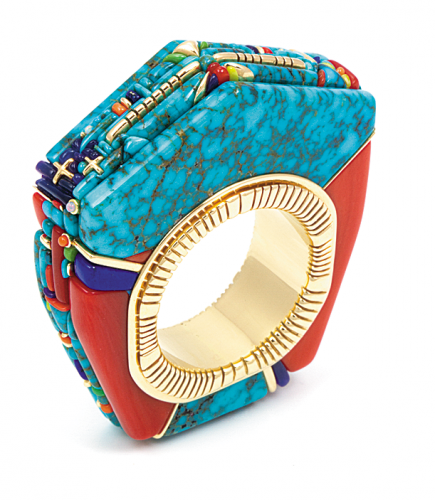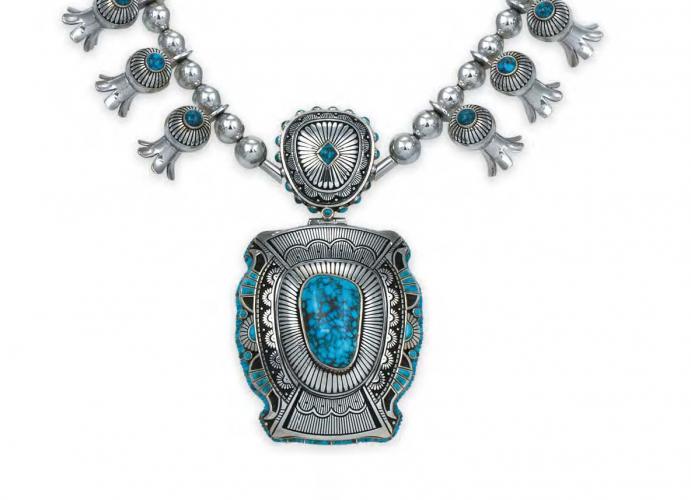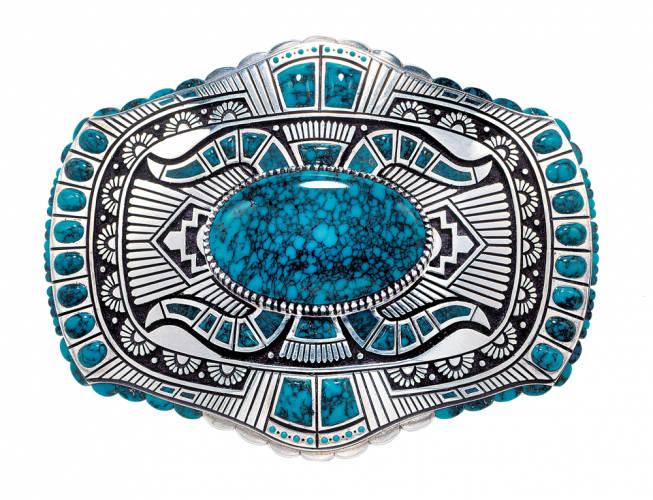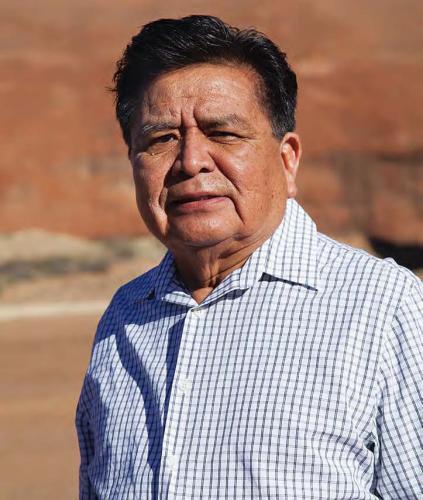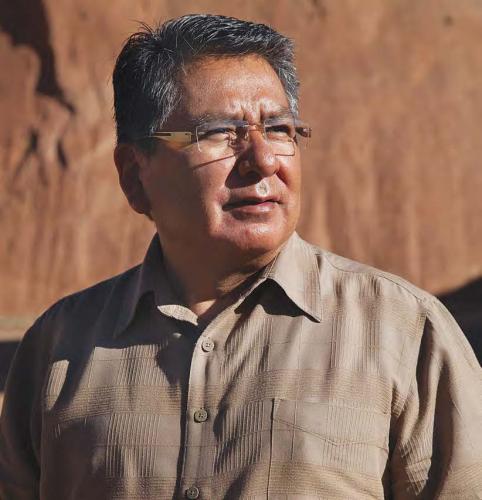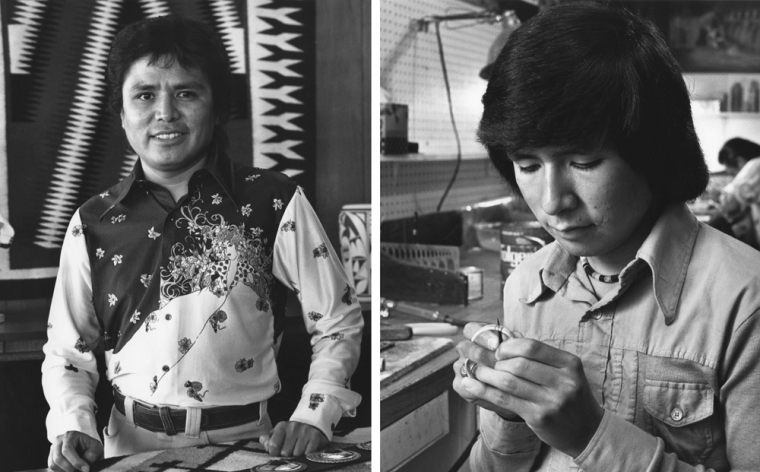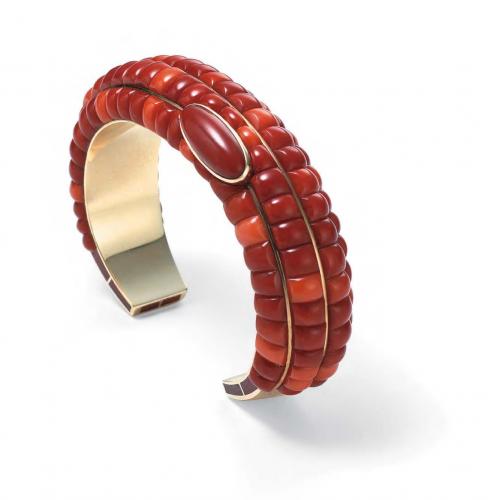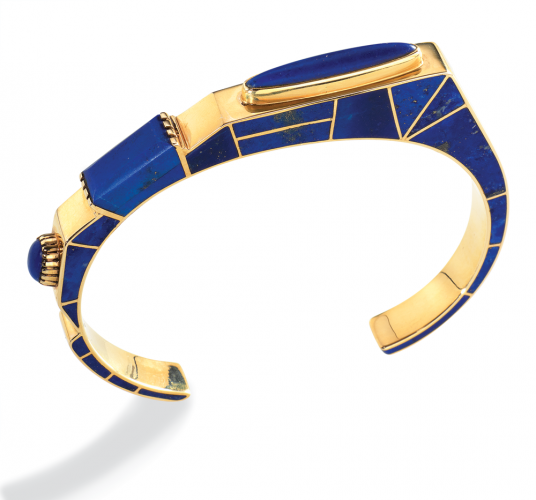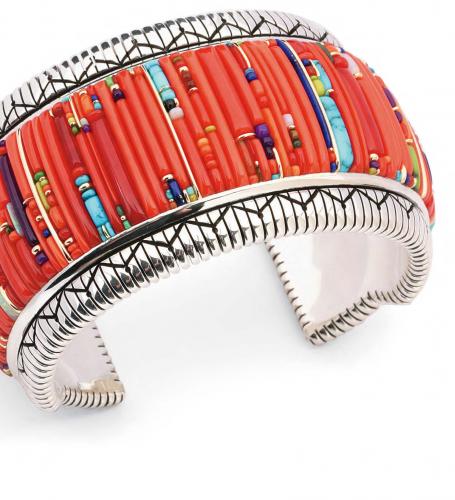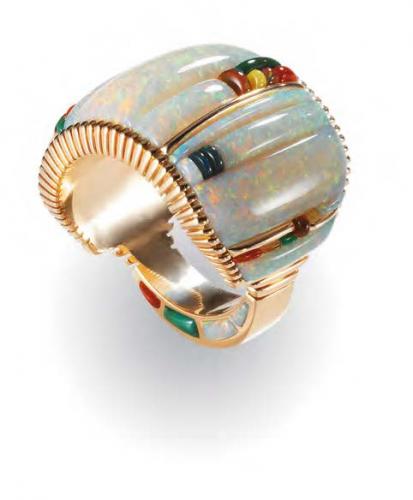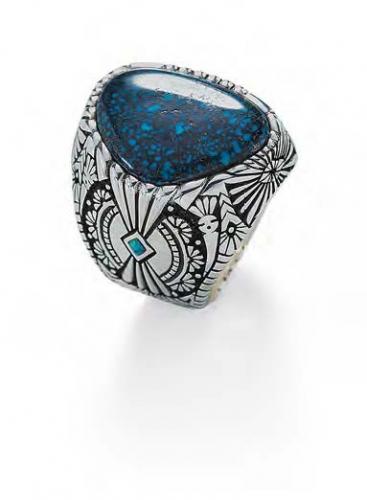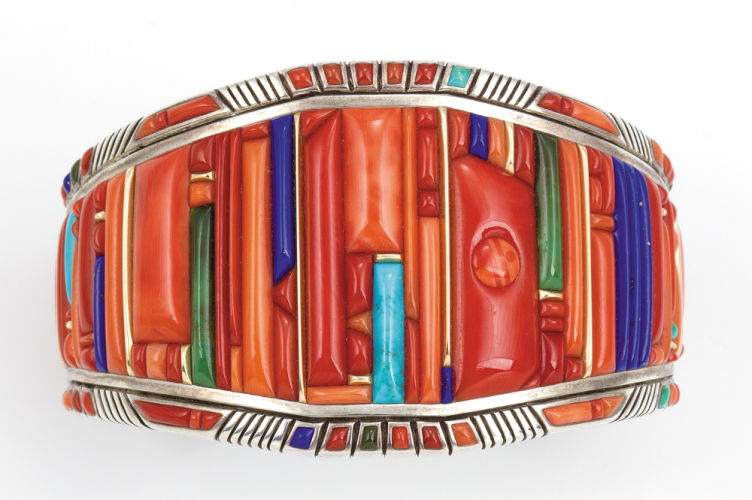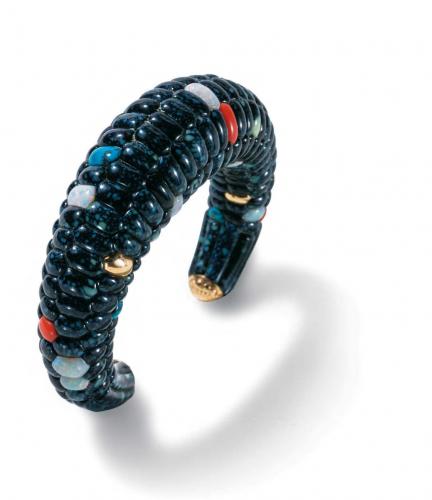One of Lee Yazzie’s earliest memories is watching his mother sitting in their home with an array of turquoise stones spread out in front of her. She would make silver rings, fashioning the bezels to hold the stones, and adding twists of wire or other pieces of silver to embellish the work.
With 12 children to feed while living in a hogan 20 miles south of Gallup, N.M., Elsie Yazzie’s time was consumed with this work; the income from the silverwork was critical. She and her husband, Chee, worked together to create concho belts, spoons and other items that he would take into town to sell to one of the local trading posts, supplementing the income he made working for the railroad. According to Lee, Elsie always seemed busy with this work but somehow also managed to give her children that special loving attention they each needed.
The parents often chased their offspring away from their projects. “It was off limits to the children because they didn’t want us to mess anything up or things to get lost,” says Lee. Instead, the youngsters improvised their own workshop, cutting up tin cans and breaking glass for their materials. “I scrounged around for different colors of glass,” Lee remembers. “There was a purple lapis Vicks bottle that I loved.” Their play also reflected the barter system of the jewelry trade, in which non-Indian businessmen provided the materials and marketed the finished products. One of the children would always be the trader.
As Lee grew older, he became more and more interested in what his mother was spending so much time doing. Lee probably never imagined, however, that this curiosity would lead to a renowned career in which his own jewelry would be sought after by collectors from as far away as Japan.
Lee, now 68, his brother Raymond, 55, sister Mary Marie, 71, and many of their siblings, children and grandchildren carry on the tradition of Navajo jewelry-making both as support for their families and as a fine art. A new exhibition, Glittering World: Navajo Jewelry of the Yazzie Family, will tell their extraordinary story, opening Nov. 13 at the National Museum of the American Indian’s George Gustav Heye Center in New York.
The title of the exhibition is taken from the Navajo emergence story, which describes a journey through previous underworlds and arrival in the bright and glittering world where we all reside today. This seemed an appropriate title for an exhibition of contemporary Navajo bling!
Glittering World will provide visitors with an overview of the history of Navajo jewelry. It will explain cultural influences as well as the impact of the trade and commercial demands of Gallup, a major center of commerce located near the Navajo, Hopi and Zuni reservations in New Mexico and Arizona, and home to the Yazzie family today. Although Lee and Raymond have achieved the greatest commercial and critical success, the exhibition will include work by siblings Mary Marie, Lillie, Lola, Marie, Shirley, Cindy and Jimmy B., and handmade silver beads by nieces Sheena and Taisheena Long.
“The exhibition turned out to be a remarkable story, past to present, of Navajo jewelry through the lens of this gifted Yazzie family,” says guest curator Lois Sherr Dubin, whose relationship with the Yazzies stretches back nearly 20 years.
“Despite hardship in their lives, they all remain connected to their Navajo upbringing and a core set of common values rooted in tradition: harmony and balance, reciprocity, respect for the family and the importance of leading a life of significance and producing work of quality.”
As a result, both the integrity of their work and their keen artistic sensibility have established their reputation as esteemed jewelers in their community and, increasingly, in the broader world of art and design. Lee and Raymond Yazzie have achieved remarkable success and recognition and will be a major focus of the exhibition.
Lee A. Yazzie
“Lee is absolutely one of the finest goldsmiths and silversmiths that there is today. Lee really doesn’t know the example he has set for us…. I think he was humbled to realize that he is one of our most important leaders.”
– Jesse Monongya, Navajo/Hopi jeweler
Lee Yazzie is a perfectionist. Always seeking to improve his work, he’s uncomfortable with being referred to as a “master,” though it is clear he has attained this status. “That is what I have tried to do in my life: to always try to make the next piece better.” Deeply inspired by traditional Navajo designs, he has become known as a master silver-worker and lapidary artist. Yet, Lee never intended to be a jeweler. His first aspiration was to complete a college education and become an accountant.
Yazzie’s plans were interrupted during his first year in college in the late 1960s by the stresses on a congenital malformation of his hip. He was forced to withdraw from school for surgery. “While recuperating from the hip operation, I turned to silver-smithing to help my mother, who was responsible for taking care of all the younger children. I made silver beads for her squash blossom necklaces,” says Lee.
By this time Chee and Elsie Yazzie had divorced and Elsie and the children had relocated to Gallup. Elsie and her daughters had started to work in the store of a local trader, Joe Tanner, in addition to producing jewelry for sale. Lee also began working at Tanner’s Indian Arts, which gave him the opportunity to work with and learn about better-quality turquoise. Eventually he began to collaborate with a fellow worker, Preston Monongye, a Hopi artist whom he sought out as a mentor. Lee stayed at Tanner’s for six years, until 1975.
For many of these years, he was frustrated because of his unfulfilled ambition to finish college and become an accountant, and simply worked for the immediate income. “I wish I understood before what I really had,” he says. “I would have been even better.”
Despite his personal dissatisfaction, during the 1970s and 1980s Lee’s reputation grew among collectors. He left Tanner and eventually began working with Gene Waddell, a gallery owner based in Scottsdale, Ariz. According to Waddell, “What sets Lee apart from other jewelers is that most Native jewelry artists are either great metal-smiths or great inlayers. Lee Yazzie is both. His metalwork is unique, totally made by his own hands with no shortcuts in quality. His mosaic inlay complements the metalwork [but] does not distract. Its balance is sublime. Lee has the ability to use the material he selects to bring out the essence of each piece. The turquoise, coral and lapis become his palate of color to bring life to his inlay pieces.”
With support and encouragement from his wife Bessie and daughters Kimberly Lynn and Karen Leigh, he overcame numerous hardships and began to focus on his work more seriously in the late 1980s.
Lee is best known for his use of turquoise, a beautiful and diverse material that is mined in numerous locations throughout the Southwest. Each mine produces turquoise with distinctive qualities of color, matrix (the various impurities that add visual complexity), hardness and luminosity. Lee is so particular about his materials he has been known to hold up commissions until he has found the perfect stone. This sense of patience and perfection has led to the creation of magnificent works of art that have propelled traditional Navajo art forms to a new level.
Raymond C. Yazzie
“I knew what I wanted to do. I didn’t have an interest in any other profession than my artwork, unlike Lee, who didn’t want to be an artist at first. My brother Benny was the one who finally told me that if you know what you want to do, pursue it.”
– Raymond C. Yazzie
As one of the youngest children, Raymond Yazzie’s path to becoming an artist was different than Lee’s. After the family moved to Gallup, several of the siblings were now adults, living in different households with their own children. Despite the change in circumstances, Raymond remembers his mother working on her jewelry for hours in their kitchen, so consistently that the sleeves of her velvet blouses frayed. By this time several family members were working for the Tanners, including Lee, and at the age of nine or 10, Raymond decided that one day he would follow in their footsteps.
At the age of 14, Raymond won his first Best of Show at the Gallup Intertribal Ceremonial. His prize-winning piece was an inlay belt. “This is what really kick-started my life in jewelry,” he says. “It was challenging, but the biggest encouragement in my life was my mom. She really encouraged us to be where we are now.”
With the support of his wife Colina, in 1997 he entered the Santa Fe Art Market sponsored by the Southwestern Association for Indian Arts. He says that at the time he had no confidence in himself, but by the second day of the market, he sold out his pieces, some at prices in the thousands of dollars.
An exceptional lapidary artist, Raymond is known for his use of color and sculptural design. Many of his more recent works have attained an almost architectural quality. Like his brother, he spends enormous amounts of time and effort in choosing his materials in order to achieve the vision of his creation. As fellow award-winning artist Pat Pruitt (Apache/Laguna) says, “Raymond is a role model for younger artists; he has truly dedicated himself to his art. The materials I use allow me to be prolific, but because his work is so labor-intensive, he has the discipline to focus in and carry those pieces to fruition, whatever the timeline may be. Not a lot of artists do that. It may take him a year and a half to create a piece, but then that piece is absolutely amazing.”
While Lee will create careful drawings and spend time measuring and planning his work, Raymond is much more intuitive. As Raymond is thinking of a piece, he says, “It is natural to me to walk into my studio and start working. I design as I go along, without sketching first. I start cutting stones and think, ‘Do I see anything here? Or should I make this one this way?’” He also has experimented with combining more materials and stones. He is especially fond of coral and sometimes uses 14-carat gold as inlay between the stones to add “more glitter.”
Raymond has branched out from his family and other Navajo jewelers in other ways, including his business practice. In 1997, he moved on from working with traders who still primarily use a barter system to open his own gallery, Yazzie Indian Art, in Gallup, together with his wife and partner Colina. He is now represented exclusively by Leota Knight, an admirer and collector of his work, based in Texas. Likewise, Lee continues to be represented by Gene Waddell in Arizona. Both brothers have attained an elite status in the Native jewelry world and are positioned to become known not just as jewelers but as remarkable international artists.
Despite their success, all of the Yazzies refuse to forget or abandon their roots, having learned about their culture and values through their parents in that hogan outside of Gallup. This humble history, despite its challenges and hardships, was an important foundation of their identity.
As Dubin states, “Navajo life is a process of constant rebalancing and perfecting one’s actions, expressions and thoughts into an ideal state: the unity of matter and spirit. The Yazzies, and their exquisite jewelry art, are quintessentially Navajo and uniquely individual. The attention to the highest standards of craftsmanship by every member of this remarkable family continues to generate an extraordinary body of work.”

